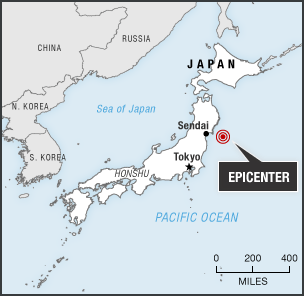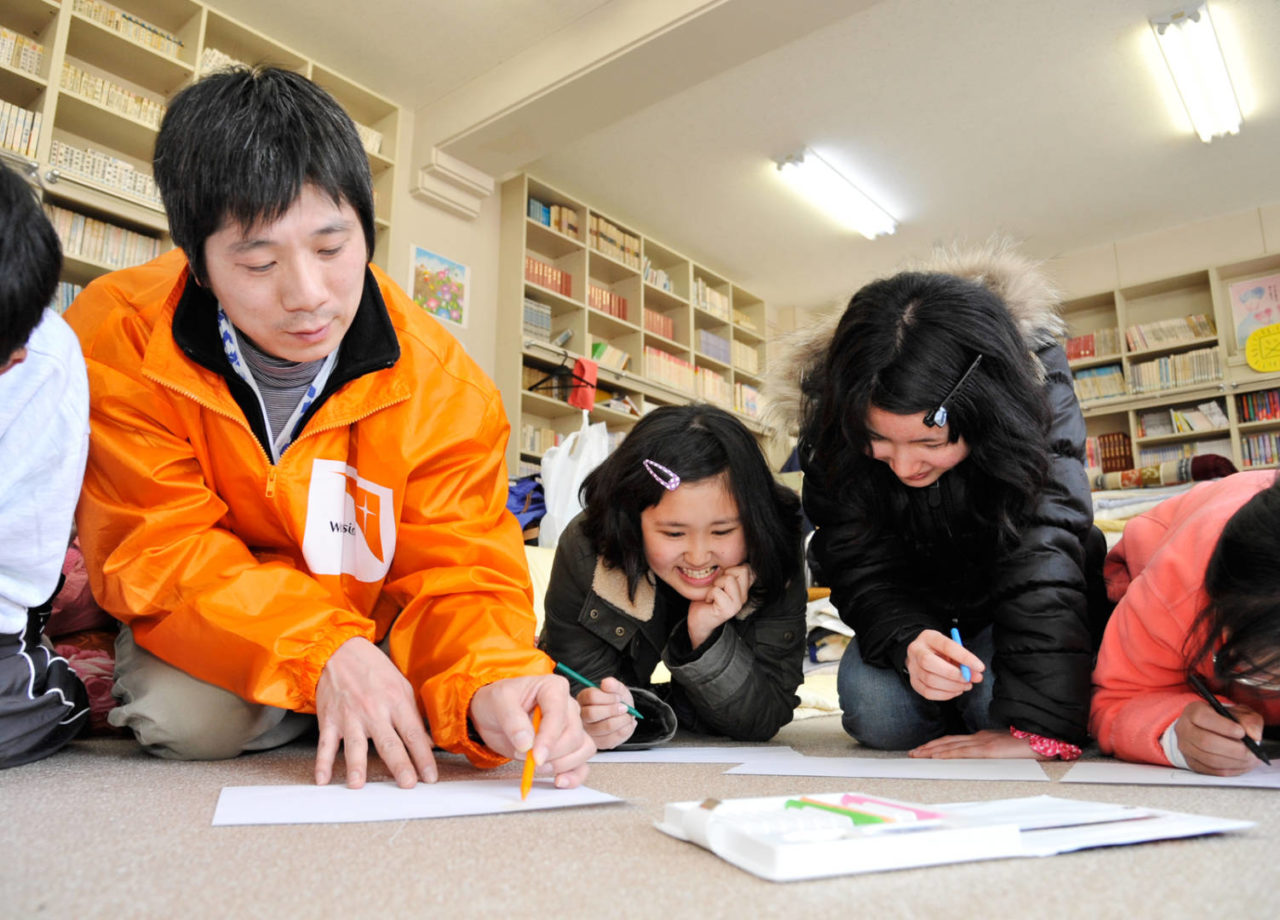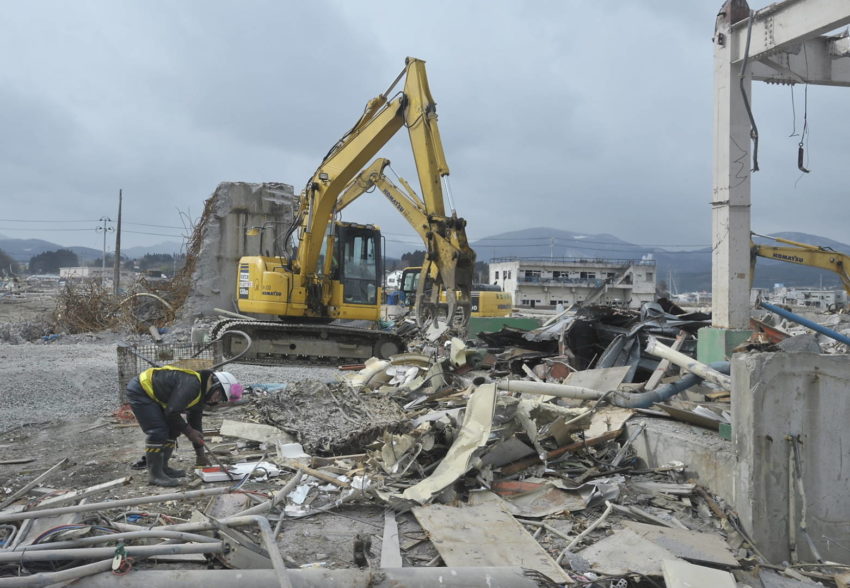A magnitude 9.0 earthquake struck in the Pacific Ocean off the northeast coast of the Tōhoku region of Japan’s Honshu island on March 11, 2011. The Great East Japan Earthquake — the name given to the event by the Japanese government — triggered a massive tsunami that flooded more than 200 square miles of coastal land. Waves were estimated to be as high as 38 meters, the height of a 12-story building.
An estimated 20,000 people were dead or missing and close to 500,000 people were forced to evacuate. In addition, a nuclear power plant meltdown triggered a nuclear emergency. The direct economic loss from the earthquake, tsunami, and nuclear disaster is estimated at $360 billion.
Though Japan is a world leader in disaster preparedness, the 2011 Tōhoku earthquake caused overwhelming damage and humanitarian needs that required an international response.
FAQs: What you need to know about the 2011 Japan earthquake and tsunami
Explore facts and frequently asked questions about the 2011 earthquake off the Pacific coast of Tōhoku and resulting tsunami, and learn how you can help people affected by disasters.
- Fast facts: 2011 Japan earthquake and tsunami
- Has Japan recovered from the 2011 earthquake and tsunami?
- What is a tsunami?
- How does the Japan tsunami compare to the 2004 Indian Ocean tsunami?
- How common are earthquakes in Japan?
- How can I help people affected by disasters?
- 2011 Japan earthquake and tsunami timeline
- World Vision’s response to the 2011 Japan earthquake and tsunami
Fast facts: 2011 Japan earthquake and tsunami
- The Tōhoku earthquake was a magnitude 9.0 — the most powerful earthquake recorded in Japan since 1900, when seismic recording devices were first used, and it is the fourth most powerful ever detected worldwide.
- People in Japan felt strong shaking for three to five minutes.
- The Tōhoku earthquake shifted the earth on its axis, according to the U.S. Geological Service.
- At $360 billion, the earthquake and tsunami resulted in the costliest disaster to date. For comparison, Hurricane Katrina’s economic impact was $250 billion.
- Nearly 20,000 people died or went missing; more than 90% of deaths were from drowning during the tsunami.
Has Japan recovered from the 2011 earthquake and tsunami?
In July 2011, the Japanese government set a 10-year timeline for recovery with specific targets for clearing debris, restoring infrastructure, and housing. So far, nearly all of the debris from the earthquake and tsunami has been recycled or incinerated. Most of the infrastructure that had been destroyed — roads, bridges, railways, and airports — has been reconstructed. Housing reconstruction is well underway, according to the Japan Reconstruction Agency.
However, the failure of the nuclear power station in Fukushima has had long-ranging effects and has made recovery difficult in the Fukushima prefecture. High levels of radiation persist at the destroyed power plants. TEPCO, the Tokyo Electric Power Company, which manages the affected power plants, expects full decommissioning of the plants to take 30 to 40 more years.
The Japanese government is monitoring food safety, agriculture and fisheries production to make sure they are within safe limits in inhabited areas.
What is a tsunami?
Tsunamis are waves caused by disruptions such as earthquakes, landslides, or volcanic eruptions under the sea that displace water. They are not moved about by winds, but are instead huge volumes of water moving from their full depth. In deep oceans, they may move as fast as a jet plane. As the waves travel inland, they pile up higher and higher walls of water. The tallest tsunami waves caused by the Japan earthquake were estimated to be as high as a 12-story building.
Tsunamis are not tidal waves because they are not influenced by the tides. A tidal wave is a shallow water wave caused by the gravitational effects of the sun and moon on the earth.
How does the Japan tsunami compare to the 2004 Indian Ocean tsunami?
The biggest difference in the two tsunamis is not in their size, but in the level of preparation and warning available to people in their paths. With virtually no warning in Banda Aceh, Indonesia, 167,000 people died during the 2004 Indian Ocean earthquake and tsunami.
The location made a difference too. Both waves were felt around the world, but the Indian Ocean tsunami caused deaths and significant damage not only in Indonesia, but in India, Sri Lanka, and Thailand, too.
How common are earthquakes in Japan?
Japan has about 1,500 or so earthquakes a year, most of them minor shocks no more than magnitude 3.9. The nation’s shaky location results from its place on four shifting slabs of the Earth’s crust called tectonic plates.
Magnitude 6.5 and higher earthquakes occur almost every year in Japan, sometimes several times. The distinction for the March 2011 Tōhoku earthquake was not only its size but also the size of the tsunami it triggered and its location near vulnerable coastal communities.
How can I help people affected by disasters?
- Give: Donate to World Vision’s disaster relief fund to bring help when another disaster strikes.
- Pray: Join us in praying for families as they recover and rebuild after earthquakes, tsunamis, and other disasters: Almighty Father, we ask for Your caring mercy on people hard hit by natural disasters, including earthquakes and tsunamis. Amid their struggle to recover, give them patience, peace, and hope that their lives will continue to improve.
2011 Japan earthquake and tsunami timeline
March 11, 2011:

- A magnitude 9.0 earthquake struck off Japan’s northeastern coast, near the Tōhoku region.
- Tsunami waves smashed the coast, causing massive damage and flooding.
- The Fukushima Daiichi Nuclear Power Plant cooling system was damaged, raising fears of a meltdown.
- Aftershocks continued, many exceeding magnitude 7.0.
Within a week:
- A nuclear emergency was declared.
- More than 1 million households had no water.
- The majority of the 270,000 persons within the nuclear evacuation zone were evacuated.
- Roads leading to coastal towns were cleared; all 14 ports were restored to receive relief goods.
- Electric service was restored to 90% of Japan’s residents.
Within a month:
- Water service was restored to 90% of residents.
- Train service was restored to the area, except for the destroyed coastal line.
2011 to 2018:
- 2011: A cabinet-level reconstruction agency was formed. Then, the Japanese government approved a 10-year timeframe for reconstruction and amended its basic disaster management plan to better prepare for multi-hazard, high-impact events.
- 2012: Of the estimated 470,000 people displaced by the earthquake, tsunami, and nuclear disaster, about three-quarters — 344,000 people — were still displaced.
- 2015: U.N. World Conference on Disaster Risk Reduction met in Sendai and approved new international guidelines for reducing the effects of disasters from 2015 to 2030. A forum on the Japan tsunami introduced best practices of planning and community involvement.
- 2016: Approximately 174,000 people remained displaced from the quake, tsunami, and nuclear disaster; 60,800 people still lived in temporary housing.
- 2017: February: Radiation levels remained high near the wrecked nuclear power plant. Fisheries were recovering; tests of water and seafood quality were within acceptable levels.
- 2018: The reconstruction authority reported that 100,000 evacuees moved into permanent housing in the past two years, so only 75,000 evacuees remained in temporary housing. About 92% of public housing units were completed. Evacuation orders continue to be lifted as communities in Fukushima were decontaminated and radiation levels normalized. Cleanup of the Fukushima Daiichi plant continues slowly.

World Vision’s response to the 2011 Japan earthquake and tsunami
In the 1960s, World Vision supported Japanese children in orphanages. But since 1987, World Vision Japan has funded child-focused programs in developing countries. World Vision was, therefore, well-positioned to provide aid after the 2011 earthquake and tsunami.
Within 48 hours of the disaster, World Vision sent its disaster assessment team to the most affected areas of Miyagi and Iwate prefectures. We assisted more than 300,000 people over three years, in coordination with government-managed recovery efforts.
March to June 2011: Emergency response
- Relief items distributed, including hygiene kits, food, blankets, clothing, and household items
- Seven Child-Friendly Spaces provided children with a safe, fun, and educational environment
- Support for education included supplies, temporary classrooms, and hot meals
- Community kitchens were furnished for evacuation centers
July 2011 to December 2012: Recovery

- Child development and protection services, including psychosocial training for teachers and Child-Friendly Spaces
- Emergency power, storage, and borehole wells for schools serving as evacuation centers
- Community development focused on senior citizens, including furnishing meeting spaces and activities
- School feeding programs
- Support to restore the fishing industry
- Child-focused disaster preparedness activities
- Assistance to Fukushima evacuees, including summer camp for children
See more details about World Vision’s programs for tsunami-affected people in the one-year anniversary report.
January 2013 to March 2014: Rehabilitation and transition
- Joint children’s program with UNESCO
- Scholarships for children from worst-affected areas
- Capacity building for local nonprofits



